Environment Southland on Thursday 13th June, released the Southland Regional Pest Management Plan and accompanying decisions report and Biosecurity Strategy.
Chairman Nicol Horrell said he believes the final plan is well placed to align with the National Policy Direction for Pest Management, while focusing on the pests which require management in the region.
“This plan and the Biosecurity strategy mean we are ready to deal with the pest challenges we already have, while also being prepared to address pest threats in the future.
“Some parts of the plan attracted a great deal of public interest and some strong debate, but it’s the community input that helps us ensure we get the best plan we can for the region, and I think we have done that.”
The proposed plan was released for public consultation, along with the draft Biosecurity Strategy, in August 2018. Over 100 submissions were received and a hearing was held in March.
A hearing panel, comprising of councillors Lyndal Ludlow, Grant Hubber and Robert Guyton, along with Muriel Johnstone (who provided specialist iwi and tikanga knowledge) and independent chair John Simmons, considered all the submissions, both written and oral, before recommending final decisions to the Council.
The plan is now subject to appeals until 5 July.
Some key elements of the final plan are:
Stewart Island – The Stewart Island/Rakiura site-led programme, including the Titī Islands and other offshore islands and islets, will go ahead as proposed, with some minor wording amendments. This will mean all domestic cats on the island must continue to be desexed and microchipped. Environment Southland will provide some financial support to ensure existing pet cats meet the requirements of the plan.
The site-led programme, which received significant support from the Stewart Island community, also includes specific rules relating to other plant and animal pests.
Omaui – The proposal for a site-led programme at Omaui will not go ahead and there will be no new rules put in place restricting ownership of domestic cats or goats in this area. Although it became very clear during the submission process that the Omaui community recognise and want to protect the intrinsic values of the area, there was insufficient support for the establishment of a site-led programme at this time. However, discussions will be held with the community to consider a revised site-led programme in the future.
Possums – Possum target areas have changed slightly, so landowners should check the maps to be sure of the possum control targets for their area. The highly successful Possum Control Area (PCA) programme will continue to be a priority for Environment Southland’s biosecurity team.
Bengal cats – The rules relating to ownership of Bengal cats, which have been in place in Southland for many years, will continue. Bengal cats will continue to be an exclusion pest, which can be owned as pets in Southland, but a permit is required and a number of rules apply. Permits should be applied for through Environment Southland.
Chinchillas – The pest classification of chinchillas in Southland has been removed, meaning there are no rules that apply to these. Research has suggested it is highly unlikely they would be able to establish a viable wild population in Southland, particularly given the climatic conditions.
Wilding conifers – Wilding conifers rules have been amended slightly from those in the initial proposal. The focus of the rules is on areas where public money has already been invested in control work and in areas which are particularly sensitive.
Gorse and broom – Gorse and broom rules will be the same for both urban and rural areas and will fall into the category of a good neighbour rule. This ensures that pests on one person’s land don’t impact on their neighbours’ properties. Good neighbour rules apply to the Crown agencies, as well as private landowners.
Undaria – The pest plan rules relating to the marine pest Undaria have been adopted as recommended by the staff report. This was an amendment to take into account the practicalities of and low benefits of enforcement when boats are only moving between already infested sites such as Bluff and Oban. The rule in the pest plan has been designed to support the Fiordland Marine Regional Pathway Management Plan in keeping Undaria out of areas which are not already infested, while still allowing boats to travel as freely as possible. Since the staff recommendation, a further discovery of Undaria in Chalky Inlet has been made. Further investigation is being carried out to understand the extent of this and a decision will then be made on how best to manage it.
You can read the full plan and the hearing panel’s decision report here

